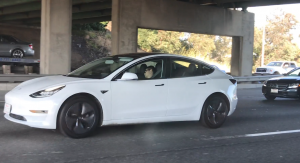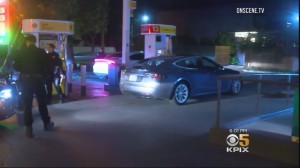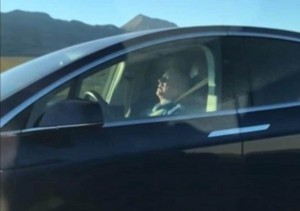
Reddit user MiloWee posted video of this Tesla Model 3 driver apparently asleep behind the wheel in traffic in Los Angeles.
For months, stories about Tesla vehicles on Autopilot being involved crashes have dotted news coverage of the California-based EV maker. However, new examples of the semi-autonomous technology is showing up, saving lives.
Drivers are posting video recordings of Tesla drivers asleep behind the wheel as their vehicles motor along in traffic.
Los Angeles’ NBC affiliate ran the footage of Shawn Miladinovich, who drove next to a Model 3 driver fast asleep on the LA’s infamous 405 freeway. He said the guy behind the wheel was “was just fully sleeping, eyes were shut, hands nowhere near the steering wheel,” Miladinovich, who was a passenger in a nearby car, told the station.
Miladinovich said he saw the vehicle twice, about 30 minutes apart, on the 405 and both times the driver appeared to be dozing each time. The California Highway Patrol was notified, but hadn’t gotten to the vehicle by the time Miladinovich’s vehicle exited the freeway.
(Tesla stock rebounds, but questions remain about production. Click Here for the story.)

This Model S owner was arrested by police after sleeping behind the wheel with the Autopilot engaged.
Footage of a sleeping Tesla driver near San Francisco was posted to Reddit’s Idiots in Cars forum recently. MiloWee, the Reddit user who posted the video, said she tried “several times” to wake him up by honking. “It worked, but he fell back asleep,” she wrote.
A quick search of the internet will turn up scores of similar reports and not just in California, but in states across the U.S. as well as examples in China, The Netherlands and other countries. Drowsy driving is an ever-increasing problem.
According to the American Sleep Foundation, about half of U.S. adult drivers admit to consistently getting behind the wheel while feeling drowsy. About 20% admit to falling asleep behind the wheel at some point in the past year – with more than 40% admitting this has happened at least once in their driving careers.
(Click Here for more about Musk hyping Tesla’s performance, future to shareholders.)
These startling figures show how prevalent drowsy driving is. What drivers may not realize is how much drowsy driving puts themselves – and others – at risk. In fact, an estimated 5,000 people died in 2015 in crashes involving drowsy driving, according to a Governors Highway Safety Association report.
According to the National Highway Traffic Safety Administration, every year about 100,000 police-reported crashes involve drowsy driving. These crashes result in more than 1,550 fatalities and 71,000 injuries. The real number may be much higher, however, as it is difficult to determine whether a driver was drowsy at the time of a crash.
Tesla isn’t the only automaker that has some form of semi-autonomous driving, such as Cadillac and its SuperCruise technology. Most of the technology, including Tesla’s, requires the driver to maintain contact with the steering wheel to keep it engaged, but there are ways to hack it.
(Tesla workers less keen on EV maker than last year. Click Here for the story.)
One of the easiest ways to make the systems tougher to hack is to uses eye-tracking technology, like General Motors and Subaru.


I’m confused. No where in this article does it explain how Autopilot “helps to avoid drowsy driver collisions.” It just talks about how many times people are spotted sleeping behind the wheel of a Tesla while it’s on Autopilot with some stats thrown in.